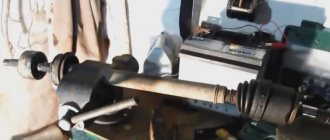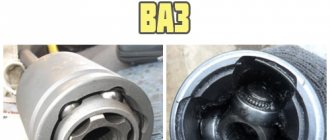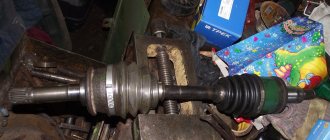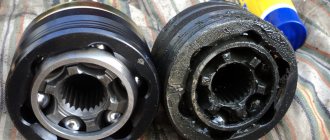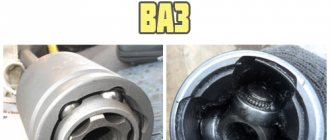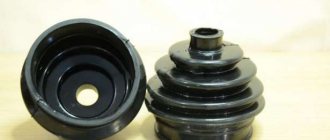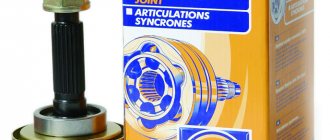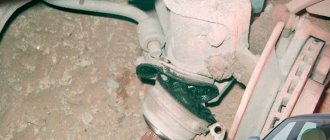02.09.2019
| (Votes: 1, Rating: 5) |
Issues discussed in the material:
- Why do you need an internal CV joint?
- What types of internal CV joints are there?
- Which inner CV joint is better?
Most modern passenger cars are front-wheel drive and have independent suspension. The angular placement of the driving front wheels constantly changes its position relative to the main gear vertically and horizontally. For SUVs and trucks, it is important that the drive and steered wheels, in addition to transmitting torque, turn. In order for this to happen, a special hinge is provided between the wheel and the axle shaft of the car. In the article we will talk about what these joints are and which internal CV joint is better.
Which outer CV joint is better?
Today, CV joints are one of the most efficient mechanisms that smoothly transmit torque from the engine through the gearbox to the turning drive wheels without loss of power. Typically, the outer and inner joints are attached to a splined shaft using thrust rings and circlips. The outer one connects to the wheel hub. It transmits torque to the wheel and ensures turning. The internal one is adapted to axial movements and is installed on the drive from the gearbox side. From it rotation is transmitted to the drive shaft. In this case, the rotation speed of the input and output shafts is the same; it does not change depending on the angle of operation of the hinge.
The best CV joint manufacturers
Automotive stores have a large selection of similar products. They differ from each other in cost and manufacturer. We list the companies whose products are in high demand among car enthusiasts.
Description. The company's CV joints do not require balancing during installation, which reduces installation time. The signature feature of German manufacturers is the availability of lubricant “to capacity”. This makes the part maintenance-free until the end of its service life.
GKN joint devices provide an optimal balance of power and torque of the vehicle engine. The anthers of the product are made from high-quality plastic and neoprene, capable of operating at high temperatures.
Equipment. The kit includes: CV joint, boot, snap ring, gasket and fasteners.
Life time. With proper operation, it lasts about 80 thousand km.
- Long working life.
- Reliable components: clamps, boot, fastening.
- Plenty of lubrication.
- Metal quickly becomes covered with rust.
- High price.
Description. The reason for the Japanese success should be sought in the use of innovative technologies in the development of parts. So, during production, the cold forging method is used. The resulting parts are coated with a protective layer of molybdenum and impregnated with carbon at high temperatures, which ensures increased strength of the products.
The company also does a lot of work to protect its products from counterfeit goods. For this purpose, original packaging materials have been developed; the name of the part on the box is covered in gold. Inside the package there is a thank you note from the manufacturers for purchasing the product: “Thank you.”
Equipment. In addition to the part itself, the CV joint kit includes a boot with lubricant, two clamps, a retaining ring and fasteners.
Life time. As car enthusiasts note, the hinged products of the Japanese company, when used correctly, can travel up to 80 thousand km.
- Long service life.
- Reliable protection against counterfeiting.
- Withstands intense loads.
- The price of the product is cheaper than the cost of the original part.
- High-quality material of anthers.
- There is a marriage.
Stellox
Description. The product is of good quality and reasonable price. Stellox sells a wide range of automotive components, including CV joints.
It should be noted that the Germans control the quality of their goods. Many car owners recommend the company's inexpensive hinges.
Equipment. The kit includes a standard set, which includes a tripod CV joint, boot, 2 clamps, a ring and fasteners.
Life time. The product is provided with a manufacturer's warranty: 1 year or 80 thousand km.
- Low prices.
- Good quality materials.
- High quality packaging.
- No vibration when driving.
- You come across parts with a short working life and begin to crunch.
Description. CV joint components are made from alloy steel and processed at high temperatures using special technology. It gives strength to the channels through which the balls move and increases the working life.
The device parts are assembled using the method of pairwise selective assembly, which ensures their high reliability.
Equipment. The kit includes CV joint, boot, clamps, fasteners.
Life time. It is noted that this CV joint, with proper operation, can travel about 80 thousand km.
- Attractive presentation of parts and packaging.
- Long service life.
- The boot material can withstand low sub-zero temperatures and does not tan.
- Good equipment: CV joint, boot, tube of lubricant, clamps, fasteners.
- Low cost of goods.
- Sometimes there are defective products.
Description. Its products are of good quality, which is confirmed by certificates of compliance with the standards of various countries. Auto parts produced by the company are sold in the markets of 120 countries.
The priority activity of GSP is the production of CV joints and drive shafts for various brands of cars from Asia, Europe, and America. Currently, the company produces more than 2,500 types of CV joints of various types.
Equipment. The kit includes a hinge, boot, clamps, and fastening parts.
Life time. With proper operation, it lasts from 70 - 80 thousand km.
- Low price.
- Good appearance.
- Wide range of hinge parts.
- They break down quickly.
- They transmit vibration when the car is moving.
- Poor quality boot material.
What brand of grenade should I choose and what boots should I install?
Almost all motorists who are faced with a breakdown of this element are wondering - which CV joint is better for a VAZ 2114 - domestic or imported? The answer to this question can be completely unambiguous - the best CV joints are the original ones, produced by AvtoVAZ itself.
The only difficulty that exists here is that such grenades have not been and are not on sale, so it is very difficult to get them.
You can either try to look for them at auto repair shops (however, here you can unknowingly buy used ones, which is not very good - after all, the part may already be damaged) or go to an official AvtoVAZ service center (but the price will be very high). For these reasons, it would be best to look at products from other manufacturers.
CV joint for VAZ 2114
So, the answer to the question which outer CV joint for the VAZ 2114 is better can be any of the following companies:
- Lobro;
- Hola;
- Kraft;
- GKN;
- GLO;
- FINWHALE;
- LPR;
- Mettelli.
GKN grenade for VAZ 2114
The first three companies on this list are especially popular among domestic car enthusiasts, so if there is a choice in a car store, it would be better to give preference to them. Also, when buying new grenades, you should not forget about buying new boots (mounting new CV joints with old, albeit “working” boots, would be a very big mistake).
It’s not worth talking in detail about which CV joint boots are best for the VAZ 2114. All anthers can currently be divided into two types - ordinary, almost no different from the anthers installed at the factory, and the so-called “reinforced”.
When buying the latter, it is worth remembering that along with them you should also buy mounting clamps of an increased size, since clamps from ordinary boots will not fit. All of these anthers have approximately the same quality, regardless of the manufacturer (some believe that silicone anthers last a little longer, but, as practice and reviews from many motorists show, the difference between silicone anthers and conventional ones in terms of service life is minimal).
The most important thing to do when buying anther is to check its quality. It must not have cracks, tears or other damage. The CV joint boots should be replaced with new ones at the first signs of wear.
Varieties
CV joints are classified according to their design features into four types:
- Ball bearings (the most common, present in all types of rear-wheel drive passenger cars).
- Paired (used extremely rarely, have a complex design).
- Crackers (they are mainly equipped with buses and trucks).
- Tripoid (used in internal structures, characterized by axial movement).
Based on their location, grenades can be divided into two types:
- External (connects wheel hubs and axle shafts).
- Internal (connect axle shafts and gearbox).
Depending on the design, grenades may have:
- 23 splines.
- 24 splines.
According to the manufacturer, all CV joints on Priora can be divided into two types:
- Original.
- Unoriginal.
The latter are cheaper. They are represented by the following brands:
- Pilenga.
- Metelli.
- SKF.
- Loebro.
- LGR Holding.
- G.K.N.
- Hofer.
- Febest.
Signs of boot failure
If there are any defects on the anthers, they need to be replaced. There are a number of signs by which you can understand that the protective case is no longer performing its function in full mode. Among them:
- The appearance of microcracks.
- Uneven wear on one side of the boot.
- A gap appears.
- The unit releases lubricant that seeps through the cover.
In all of these cases, the external or internal boot will need to be replaced with a new one.
Take into account that the operation of a damaged boot will lead to more serious damage that will occur if the hinge part of the assembly is contaminated.
Replacing CV joints
In order to replace a failed grenade, it is not at all necessary to contact a service center. The motorist himself is quite capable of performing this procedure.
Tool
In order to replace CV joints, you will need the following set of tools and accessories:
- jack;
- shoes;
- set of socket heads;
- spanners;
- special lubricant for CV joints;
- a clean cloth or rags;
- new anthers.
To increase the service life of CV joints, you should regularly check the condition of their boots. Even a small crack on the boot can cause the CV joint to fail.
The repair itself can be carried out anywhere, but it will be much better if the car can be placed on an overpass or placed above a sufficiently deep repair pit - this will greatly facilitate the efforts of the car enthusiast and make the process itself more accurate.
Process
The entire replacement of grenades occurs as follows:
- Turn off the engine and put the car on the handbrake.
- Stop the wheels with shoes (if necessary).
- Using a bolt remover, unscrew the wheel bolts.
- Raise the front of the car.
- Remove the retaining ring in the center of the grenade.
- Using a 13mm wrench, unscrew the fasteners of the ball joint in the upper part (it is not necessary to unscrew the fasteners of the lower part - they will not interfere with the process).
- Using a pry bar, slightly move the support out of the grooves.
- Knock the hub off the CV joint splines (use a soft hammer or spacer board!).
- Remove the broken CV joint.
- Check the mounting rod for damage.
- Remove old grease from the rod using a cloth.
- Install the new CV joint in place (namely, the CV joint itself, retaining rings, nuts, clamps and a new boot).
- During assembly, the assembly should be generously, but not excessively, lubricated with a special lubricant.
After the new CV joint is installed in its place, all that remains is to reassemble the entire assembly in the reverse order. At the same time, it is worth paying special attention to the installation and tightening of the hub lock nut - this should be done exclusively using a torque wrench and tightened strictly with the force specified in the car’s passport. But we’ll talk about which grenade is better to put on a VAZ 2114 below.
Which grenades are better for the VAZ 2114: choosing the best option
Before considering the main topic of the article - which grenades are better for the VAZ 2114, you should first understand what this part is. A CV joint (otherwise called a grenade because of its characteristic shape) is an element of the front suspension of a car, extending from the hub of each wheel. It has an oblong shape with a thickening at the end. Its main purpose is to transmit torque at maximum rotation angles (reaching 70 degrees).
CV joint VAZ 2114
As for its service life, it can be noted that initially CV joints were created as elements with a very long service life (in some cases equal to the service life of the car itself). But, in practice, damage to the grenade occurs quite often, and the main reason for this is wear or cracks on the CV boot, allowing dust and dirt to get inside, violating the integrity of the structure and causing its damage.
Checking the damage to the grenade is quite simple - you just need to turn the car's wheels as far as possible in any direction and inspect the suspension. If the boots are damaged (that is, have cracks or tears), they should be replaced immediately. And in a situation where a grinding or other extraneous noise emanating from the suspension is heard while driving, conclusions can be drawn about the damage to the grenade and its failure.
In this case, it is categorically not recommended to continue driving - firstly, it is very dangerous and can lead to road accidents, and secondly, driving with a faulty CV joint can lead to the breakdown of a number of other parts and mechanisms, as a result of which the total cost of repairs is significantly will increase.
CV joint location
If the CV joint is damaged and noise is heard from the front suspension, it is absolutely forbidden to continue driving. This can not only lead to damage to other elements of the car, but is also very dangerous to life.
Removing and replacing the Lada Priora CV joint
Good afternoon, today we will tell you how to remove and replace the Lada Priora CV joint. If, while driving, you begin to hear humming and knocking noises in the area of the front wheels, and a crunching sound when cornering, then it’s time to change the CV joints, that is, constant velocity joints that transmit torque to the wheels. Car enthusiasts also call this part a grenade.
Additional evidence of a grenade failure will be the formation of a backlash, which can be easily determined. In this case, it is enough to shake the front wheel drive shaft joint with your hand. Even its slight movement indicates the need for replacement.
Removing and replacing the Lada Priora CV joint
Article: Outer CV Joint - 77205S. Inner CV joint - FJ-228.
Tools: To remove and replace the inner and outer CV joints of the Lada Priora, you will need pliers, a hammer and a block or a wooden block.
Removal and replacement of the Lada Priora CV joint is carried out on a lift or inspection pit. In general, this procedure is the same for all domestic front-wheel drive cars, such as VAZ 2108, 2109, 2110, LADA Granta.
Repair or replacement of the Lada Priora CV joint is carried out with the front wheel drive removed. The first step is to remove the boot from the grenade by holding the removed drive shaft in a vice.
Replacing CV joints on Lada Priora
Using pliers, we bend the inner clamp and open the lock of the dirt cover, and do the same with the outer clamp.
Replacing the outer CV joint of Lada Priora
We move the boot along the shaft towards the center and turn it inside out.
Now you need to knock out the inner CV joint from the shaft. To do this, use a hammer and a soft metal drift. When manipulating with a hammer, forces are applied to the hinge cage.
We knock out the CV joint from the shaft
Installing a new joint will require plenty of lubrication. Drive in the SHARS using a hammer and a wooden plate, which is applied to the outer end of the shank, after which sharp blows are applied with the tool.
After installing a new grenade on the shaft, it is cleaned of dirt and thoroughly lubricated again. The lubricant has excellent sealing properties, which will provide friction units with reliable protection from moisture and dirt. Then put on the boot and secure it with clamps.
The outer or outer joint is replaced after both the outer and inner CV joints are removed. The dirt cover is also turned inside out, the shaft is clamped in a vice and the outer CV joint is knocked out of it.
Replacement of external CV joint of Lada Priora
Its installation is similar to the internal hinge
However, there is one important difference when using lubricant. It should be two times less than in the inner CV joint
Finally, all removed parts are installed in the reverse order. After installing new grenades, the car goes through any turns smoothly and without unpleasant sounds, and the process of driving on a straight road becomes much quieter.
A little theory
CV joints (constant velocity joints) perform one single, but very important task, namely the transmission of torque at rotation angles of up to 70 degrees relative to the axis.
CV joints are used only in all-wheel drive and front-wheel drive vehicles to ensure the front wheels turn and rotate under load.
CV joints are divided into:
- Internal
-
transmit torque from the gearbox to the drive shaft. - External
-
transmit torque directly to the wheels.
I will not analyze in detail the structure of CV joints, since the article will turn out to be too long and tedious, and you decided to read it only in order to find out how to carry out a quick and effective diagnosis. Therefore, I will simply advise you to check the CV boots more often, since some manufacturers themselves say that generally CV joints only have to be changed when the boot breaks.
Well, now let's get straight to the point.
CV joint with ball bearings
In general, the part is a housing with a driven shaft (trunnion), into which a holder (knuckle) is inserted. On the inner surface of the body and the outer side of the cage there are guide grooves along which six balls move, held by the separator. The splined part of the drive shaft is inserted into the central hole of the knuckle. To ensure stable operation, the installed hinge is filled with lubricant and sealed with a rubber or silicone boot. For ball CV joints, thick lubricants with molybdenum disulfide are used.
So what determines the price?
Manufacturing a high-quality Tripod requires the use of the latest machines, the best materials and the work of leading specialists. The manufacturer converts absolutely everything that makes a CV joint reliable and durable into a monetary equivalent:
- The metal inside the bowl is hardened to increase strength. In this case, the surface of the treated metal begins to shimmer in different colors, as it is covered with an oxide film;
- The use of durable metals that can be deformed. When testing CV joints, the products should not break;
- Thermoplastic anthers are used, which are highly resistant to aggressive external environments. Such anthers last much longer than conventional rubber ones;
- Special seamless anthers are created. Even if the manufacturer refuses thermoplastic, he tries to use only seamless boots. They do not have pronounced weak points where cracks and tears appear.
Attention is also paid to production culture. All parts must be closely adjusted, kept clean, and checked for defects. And all this costs money. If, in the case of OEM joints, you actually pay some extra money simply for the fact that you decided to take the original, then a high-quality analogue will still not be cheap - the CV joint is a rather capricious device, and it is not easy to manufacture.
When is replacement required?
The hinge mechanisms of the Lada Priora, which transmit rotation from the engine to the front wheels, are considered quite reliable and in some cases last 100-150 thousand km. Grenades should be replaced in the following cases:
- The car's mileage is more than 100 thousand km;
- the parts of the unit have become unusable, as evidenced by crunching sounds when turning the front wheels.
The first type of replacement is preventative. Recommended for motorists for whom a car is a tool for making money, which must be constantly in combat readiness and serve without fail. Replacement due to wear is a more common option; it is practiced by most Priora owners.
In order to change expensive CV joint parts as rarely as possible, it is important to promptly detect torn boots, through which dirt and dust enter the mechanism. Grenades cannot be repaired; they only need to be replaced. It is much easier and cheaper to replace leaky anthers so that the assembly lasts as long as possible.
Features of the tripoid joint
Due to the use of needle bearings, tripoids are more resistant to wear, and friction losses of elements in the assembly are also reduced.
Characteristics of tripoid CV joints:
- Possible bending angle up to 18 degrees,
- Maximum axial movement up to 55 mm,
- Engine and gearbox vibration compensation more than 60%.
Also, the tripoid cannot immediately fail, immobilizing the car, which is important for lovers of off-road driving. Despite the sharp crunch and vibrations that arise, the emergency tripoid CV joint will allow you to get to the repair site under your own power.
CV joint design
At the beginning of the last century, many CV joint designs were developed, which are used to this day. For example, cracker or cam, cam-disk, ball with dividing grooves or with dividing levers, with spherical rollers and a fork, paired cardan shafts. All CV joints have both advantages and disadvantages. The performance of each design is better for some conditions and not so good for others. Therefore, there is no question which design is more successful.
For external drive joints of modern fast passenger cars, the characteristics of a ball joint with 6 balls turned out to be better. The CV joint body and the inner ring under the separator, which keeps the balls from falling out of the CV joint, have the same number of grooves for them. The connection of the inner ring with the drive and the CV joint housing with the hub is splined. At large angles of rotation of the drive wheels, the maximum permissible torque transmitted by the hinge is much less than at small angles. Therefore, for long-term trouble-free operation of the CV joint, it is necessary to prevent it from working with a heavy load in the extreme positions of the steering wheel. Each CV joint is necessarily protected by a boot.
Tripoids are often used as internal grenades. They are less mobile, but more wear-resistant, since needle bearings are used in their design.
Read more about weak points
All car hinges are made in such a way that the parts fit very tightly. The entry of water or small solid particles into small gaps in the structure leads to the rapid formation of rust and abrasion of the metal. For this reason, CV joints have boots - cone-shaped covers that protect a part that is very capricious in terms of operating conditions.
When the boot ruptures, substances enter the hinge, which, after accumulation, turn into a strong abrasive. As a result: complete destruction of the node. Repair of the CV joint in this case is impossible, although repair of simpler ball joints suffering from the same abrasive can be carried out.
This cannot be called a weakness, but it cannot be ignored either. Moving parts, although made of especially durable metal, age over time and are less able to withstand loads. For this reason, the CV joint in rare cases can travel more than 200 thousand kilometers, even if the condition of the anthers was monitored by craftsmen.

